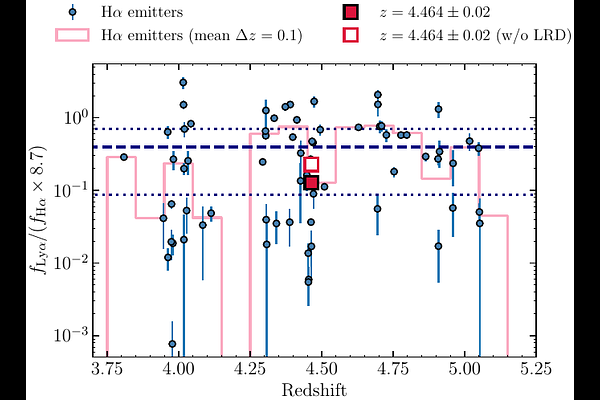A weak Ly$α$ halo for an extremely bright Little Red Dot. Indications of enshrouded SMBH growth

A weak Ly$α$ halo for an extremely bright Little Red Dot. Indications of enshrouded SMBH growth
Alberto Torralba, Jorryt Matthee, Gabriele Pezzulli, Tanya Urrutia, Max Gronke, Sara Mascia, Francesco D'Eugenio, Claudia Di Cesare, Anna-Christina Eilers, Jenny E. Greene, Edoardo Iani, Yuzo Ishikawa, Ruari Mackenzie, Rohan P. Naidu, Benjamín Navarrete, Gauri Kotiwale
AbstractThe abundant population of "Little Red Dots" (LRDs)-compact objects with red UV to optical colors and broad Balmer lines at high redshift-is unveiling new insights into the properties of early active galactic nuclei (AGN). Perhaps the most surprising features of this population are the presence of Balmer absorption and ubiquitous strong Balmer breaks. Recent models link these features to an active supermassive black hole (SMBH) cocooned in very dense gas ($N_{\rm H}\sim10^{24}\,\rm cm^{-2}$). We present a stringent test of such models using VLT/MUSE observations of A2744-45924, the most luminous LRD known to date ($L_{\rm H\alpha}\approx10^{44}~\rm erg\,s^{-1}$), located behind the Abell-2744 lensing cluster at $z=4.464$ ($\mu=1.8$). We detect a moderately extended Ly$\alpha$ nebula ($h\approx5.7$ pkpc), spatially offset from the point-like H$\alpha$ seen by JWST. The Ly$\alpha$ emission is narrow ($\rm FWHM=270\pm 15~km\,s^{-1}$), spatially offset to H$\alpha$, and faint ($\rm Ly\alpha=0.07H\alpha$) compared to Ly$\alpha$ nebulae typically observed around quasars of similar luminosity. We detect compact N$\,$IV]$\lambda$1486 emission, spatially aligned with H$\alpha$, and a spatial shift in the far-UV continuum matching the Ly$\alpha$ offset. We discuss that H$\alpha$ and Ly$\alpha$ have distinct physical origins: H$\alpha$ originates from the AGN, while Ly$\alpha$ is powered by star formation. In the environment of A2744-45924, we identify four extended Ly$\alpha$ halos ($\Delta z<0.02$, $\Delta r<100$ pkpc). Their Ly$\alpha$ luminosities match expectations based on H$\alpha$ emission, indicating no evidence for radiation from A2744-45924 affecting its surroundings. The lack of strong, compact, and broad Ly$\alpha$ and the absence of a luminous extended halo, suggest that the UV AGN light is obscured by dense gas cloaking the SMBH with covering factor close to unity.